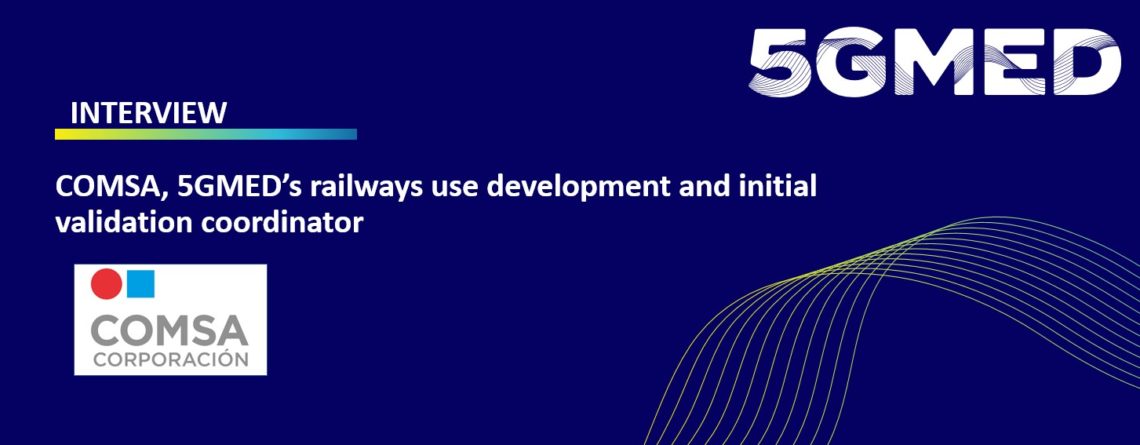COMSA, 5GMED’s railways use development and initial validation coordinator
COMSA Corporación is a global group focused on infrastructure development, industrial engineering and services with more than 130 years of experience in the execution of large scale works with a high technological component, such as the extension of L4 of the São Paulo Metro in Brazil, the supply and installation of ITS systems in several road tunnels in Colombia, or the development of the facilities and telecommunications contract at the headquarters of CERN, the world’s largest particle accelerator (France and Switzerland), among many other projects in more than 20 countries, mainly in Europe and Latin America.
In 2020, COMSA Corporación invested more than 7 million euros in R&D&I activities. The main innovation projects in which it collaborates are related to the deployment of the 5G network in the railway sector, as well as the development of tools for the predictive maintenance of infrastructures.
Could you describe your role in the 5GMED project?
COMSA coordinates the multi-bearer solution to connect onboard cells to ground servers, that provide 1Gbps services to passengers and train operations. Besides this overall coordination, COMSA is responsible for the design, deployment and integration of a 1Gbps 70Ghz network along the track and the train network. COMSA is responsible also for the WiFi internet access service.
How will be the train and railways structure of the future?
The multi bearer nature of the 5GMED connectivity solution addresses the multistakeholder nature of the networks required for the provision of communications and computer-based services in railways. The following drawing shows this structure on the train:

The 5GMED train shows four means of connectivity, satellite from Hispasat, shared 5GNR @3,5Ghz from CellNex/Vodafone, dedicated along the LFP railways corridor @ 70Ghz from the railways’ infrastructure manager deployed by COMSA and dedicated @ 26Ghz from CellNex.
The TCU provides intelligent aggregation of traffic under performance and costs criteria. The services are provided via Ethernet interfaces, WiFi points of presence or onboard 5GNR cells. Services comprise Voice, Internet Access and Infotainment from MEC for passenger and rail operational services like IoT and AI-based on MEC.
The dedicated railways’ communication network structure at 26Ghz or 70Ghz is the following:

Satellite and 5GNR Mobile Network Operator Networks are shared with the road user case in this project. 5GNR Stations and satellite representations are not shown for simplicity. Dedicated 5GNR could also be deployed along the track. Mobile Edge Computing distributed along this network has a main role in supporting the mentioned AI operational applications.
Could you present the impact of the project in short term and long term?
The current 1Gbps train to track radio network cost per km is around 200K€/km for the infrastructure manager, for the support of all critical and non-critical services, according to the European Rail Infrastructure Managers (EIM) association and the Community of European Railway and Infrastructure Companies CER with inputs from UIC, UNIFE/UNITEL and members of the European Rail industry. This cost is only CAPEX and assumes no tunnels or other challenging infrastructure elements such as bridges or extraordinary terrain conditions. Yearly OPEX is estimated at 20% of CAPEX.
There are many cost-saving opportunities with the sharing of active equipment. The short-term impacts of this project are to bring tools for strong collaboration between railways, roads and MNOs reducing this cost to less than half for non-critical services, and in the future to be able to include critical services support for a number of railways scenarios.
Does the train’s velocity adversely affect the quality of the signal? If so, how can we ensure uninterrupted communication?
In general, this is the case, but depending on the modulation implemented by the different technologies, and the switching technology between poles used, is possible to avoid this impact and still support 1Gbps to trains above 300km/h, which is a target for this project.
What is the existing radio network architecture to support the 1Gbps that is intended to be enhanced by the 5GMED proposal?
The existing track to train radio proposals are based on the staking of multiple 5GNR shared cells to cover all services required by the railways:
- Use of available spectrum in the 700, 900 and 1,800 MHz bands
- Use of 1900 MHz (10 MHz) (railways dedicated)
- Use of the 3.5 GHz band.
Multiple cell stacking brings more civil works and power with high Capex & Opex and slow deployment.
What are the values of the specific solutions used in the trial for the railways: 26Ghz along track, 70Ghz along track, 5GNR at 3,5Ghz and satellite?
The 70Ghz solution brings an ultra-low latency 1Gbit/s, simple, shared, cost-effective, all communication services support and secure solution:
- One radio/antenna for all services on board & track, and simple QoS based network with clock synch for sharing between Rail & MNO.
- Very low civil works and fast deployment.
- Free 70Ghz spectrum for IM investment
- Open & transparent: No adaptation required.
- Encryption and confined radio along track for secure solution.
- GPS geolocation.
Do not miss our next interview, follow us on our social media for more: Linkedin – Twitter.


